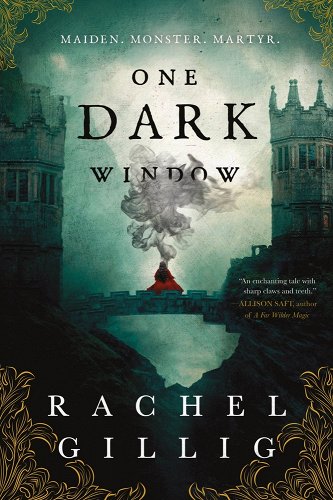The opening chapter of Rachel Gillig’s debut novel One Dark Window, is itself a dark window, inviting readers to look into the misty woods where shadows stalk, explore the medieval town of Blunder with its superstitions and prejudices, and collect the arcane “Providence” cards (not unlike a Tarot deck or a set of Oracle cards) that bestow certain magical powers upon the wielder. Gillig renders this world in delicious, evocative prose and familiar Gothic imagery. Much of the narrative follows Elspeth Spindle, whose family has kept the knowledge of her “infection” a secret from society at large. Infected children, learns the reader, often manifest supernatural abilities and hence, are swiftly put to death in the King’s dungeons. But Elspeth’s family does not know that she carries a five-hundred-year-old spirit at the back of her mind: the “Nightmare” who grows stronger as she (the Gothic heroine in every sense of the term) slowly degenerates.
Peppered with poetic epigraphs, spells, and aphorisms, Gillig builds her folk horror tale slowly and smartly. Elspeth’s yellow-eyed Nightmare speaks almost entirely in rhyme even as he bestows her with the strength to fight her assailants. In a Cinderella-like twist, her stepmother looks down on her, so Elspeth grows up with her aunt’s family at the edge of the woods instead. Upon being invited to the Equinox festivities at the King’s castle, she discovers that her debt-ridden uncle has bargained away a Providence card and his daughter Ione. As a consequence, Ione will be the wife of Prince Hauth, the King’s brutish son and heir apparent, thereby giving the family a chance at political power. But Elspeth has little time to dwell on her cousin’s predicament, as she is pulled into a conspiracy plot led by Ravyn Yew, the Captain of the King’s “Destriers,” the soldiers who are tasked with maintaining law and order as well as hunting down infected children. Ravyn’s family seeks to collect twelve unique Providence cards before the King beats him to it, and to undo the Spirit of the Woods’ ancient curse upon the land.
Gillig’s dark fantasy debut can be easily situated in the vein of folkloric novels such as Naomi Novik’s standalone Uprooted (in which the Woods itself plays the antagonist) or Katherine Arden’s The Winternight trilogy (that postulates a conflict between local folk magic traditions and the growing influence of religious orthodoxy). But One Dark Window’s utilization of a magic system inspired by traditional Tarot cards is certainly unique and commendable. The book also keeps reminding the readers that magic always has a cost. For instance, the Shepherd King drove a bargain with the Spirit of the Woods, bartering away his soul (among other things) for the magical Providence cards. The cards, in turn, exact a toll on each user. However, unlike Tarot cards, which are primarily used for fortune-telling or probing one’s unconscious to explore deep-seated issues, the Providence cards imbue the user with mystical abilities. The Scythe card lets the wielder influence the will of others at the risk of physical pain, the Nightmare card can be used to read minds, the Maiden card enhances one’s beauty even as it turns them cold-hearted, the Chalice card is frequently used as a truth serum, and so on.
After Gillig is done explaining how the Providence cards work, she swiftly moves to the next part of the novel which follows a straightforward quest narrative, with a dash of romance. Ravyn’s family is only short three cards of completing their deck. They enlist Elspeth’s help to rob the Iron Gate card from one of the influential families by pretending to be highwaymen and ambushing them in the woods. Later on in the story, Elspeth’s father gives up the Well card while she recovers from a poisoning. But the most powerful card, the Twin Alders (of which only one copy exists), remains elusive to them and to the reader, owing to a disappointing cliffhanger ending.
Of course, this isn’t the first time that Tarot symbology has influenced the narrative of a novel. As early as 1932, Charles Williams (a member of The Inklings—the literary cohort that included the likes of J.R.R. Tolkien and C.S. Lewis) wrote The Greater Trumps, a supernatural novel with Christian overtones concerned with the search of the “original” Tarot deck, capable of summoning the powers of the universe. Later, in 1973, Italo Calvino penned The Castle of Crossed Destinies with the help of two Tarot decks. The novel is a post-modernist exercise in meaning-making where the characters are devoid of speech and have to rely on the images in Tarot cards to communicate with each other. Last year, M.A. Carrick wrote The Mask of Mirrors, the first of a promising dark fantasy trilogy, with detailed worldbuilding that included its own set of “pattern” cards to foreshadow important events and character motivations in the novel. In the genre of YA where Gillig operates, notable works include Irish novelist Caroline O’Donoghue’s All Our Hidden Gifts (in which the protagonist discovers a Tarot deck with an extra, mysterious card that sets off a chain of events) and Kresley Cole’s The Arcana Chronicles (where the Major Arcana cards are reincarnated as characters in the series and participate in a Hunger Games-style competition in a post-apocalyptic setting).
A typical Tarot deck consists of 78 cards, divided into two suits. Evolved from Italian playing cards that were lavishly illustrated for the nobility, the Tarot attained occult significance much later. Roughly from the late 18th century onwards, Tarot cards were pioneered through the efforts of secret societies such as The Hermetic Order of the Golden Dawn and began making an appearance in esoteric spells and rituals. Gillig’s Providence cards are also 78 in number, even as they eschew the other conventions of such decks (except for the Prophet card that can vaguely foretell the future and the Chalice card that is used by the nobility as a drinking game that forces others to reveal the “truth”). Nevertheless, they draw upon this mystical tradition, in which the images not only contain layers of meaning but also function as cultural repositories of an older folk magic.
In our world and Gillig’s, folk magic has always been a threat to the establishment and to organized religion. The infected children in Gillig’s novel are put to death as they represent the unlawful use of magic, as well as the chaotic natural world that man seeks to tame. Providence cards, on the other hand, can be wielded by the King and other influential families, representing the need to restrict magical and political power to favored members of the nobility, which of course has real-world parallels to witchcraft trials, the Spanish Inquisition, and the erasure of indigenous magic traditions and oral cultures. To no one’s surprise, Elspeth gradually uncovers the bloody ancestral history that has tied the town of Blunder for generations. Gillig chooses not to resolve these narrative threads and takes the typical YA fantasy route of baiting the reader with the promise of a sequel.
Nevertheless, One Dark Window is a page-turner. Gillig’s lush language is somewhat reminiscent of Alix E. Harrow’s excellent portal fantasy, The Ten Thousand Doors of January, as well as Robin McKinley’s redolent fairytale retellings such as Spindle’s End, Beauty, and Deerskin, in which evocative prose and atmospheric settings take precedence over plot and characterization. Gillig’s own prose is steeped in rhymes and Gothic signifiers (wilting roses, crumbling stone castles, Grimms’ fairytale woods, and so on) that carefully construct a richly detailed and decadent world that at once feels familiar, distinctive, and wistful to the reader.
One Dark Window not only engages with the Gothic genre aesthetically. As stated before, Elspeth acts like the textbook Gothic heroine, with limited agency and freedom in a patriarchal world where those in power are deeply suspicious of any unsanctioned magic. Her magical powers and superhuman strength stem from the masculine parasitic spirit that has built a home in her mind and body. Every time she calls upon the Nightmare for help, she weakens. Under the pretext of a courtship with Ravyn, she can escape her family’s machinations, although she is only valuable to the Yews on account of her magical powers. The steamy romance that blossoms between them, although predictable and genuine, is built upon unequal power dynamics. This is a world where women can have limited power by arrogating masculine attributes (like Ravyn’s sister, Jespyr, who can ride and fight) or by courting a powerful man (like Ione who sacrifices her innocence and naivete to be the cold-hearted fiancee of Prince Hauth). The tragedy that befalls our protagonist stems from this ceding to male power.
Yet, despite the enticing Gothic trappings, One Dark Window still suffers from the usual pitfalls of the YA genre. The characterization is pretty straightforward for the most part, relying heavily on “telling”—we are told repeatedly what a “brutish” person Prince Hauth is, establishing him as one of the primary villains in the text. Another issue that plagues One Dark Window and several other contemporary YA/fantasy novels (recent examples that come to mind include Holly Black’s Book of Night and Sunyi Dean’s The Book Eaters, both published this year) is the pacing and total dependence on predictable three-act story structures. In this structure, the first half of the novel is filled with intricate worldbuilding and slow exposition, while the latter half rapidly devolves into the characters rushing towards a cinematic climax, involving a family drama of some sort, but does so without sufficiently engaging with the magical world. Gillig’s novel too suffers from this, albeit to a lesser extent, as it finds a way to interweave the legend of the Shepherd King and the Spirit of the Wood into the dramatic present, along with a predictable romantic subplot that relies on fanfic-y tropes to sustain its momentum, rather than on actual chemistry.
The overall effect is one of safe and sanitized storytelling without taking any risks, catering to a crowd that craves the familiar alongside escapist enjoyment (as mainstream publishing is extremely fond of doing). But perhaps the most frustrating aspect of the novel is that, despite having the feel of a self-contained story (like Novik’s Uprooted or Sharon Shimm’s underrated YA court intrigue novel, Summers at Castle Auburn), it ends on a cliffhanger, leaving several plot threads emotionally unresolved, including the exact fate of our protagonist. Without a sense of closure, this form of forceful sequel-baiting can feel annoying to the average reader. Although One Dark Window is an enjoyable and engaging read, the novel plays it safe instead of improvising upon genre, even when it has a unique enough premise to do so.

FICTION
One Dark Window
By Rachel Gillig
Orbit
Published September 27, 2022

